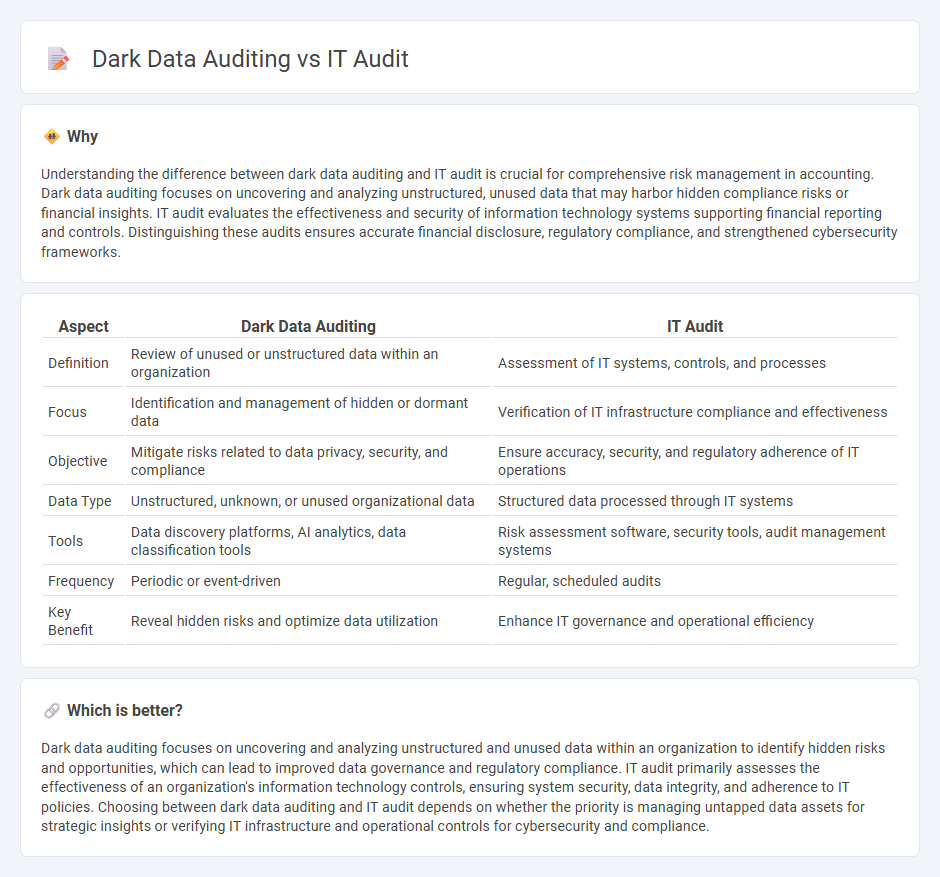
Dark data auditing uncovers hidden, unused information within organizational systems, focusing on risks and compliance challenges often overlooked in traditional evaluations. IT audits concentrate on assessing the effectiveness, security, and control of an organization's information technology infrastructure and processes. Explore how these auditing approaches complement each other for comprehensive risk management and regulatory adherence.
Why it is important
Understanding the difference between dark data auditing and IT audit is crucial for comprehensive risk management in accounting. Dark data auditing focuses on uncovering and analyzing unstructured, unused data that may harbor hidden compliance risks or financial insights. IT audit evaluates the effectiveness and security of information technology systems supporting financial reporting and controls. Distinguishing these audits ensures accurate financial disclosure, regulatory compliance, and strengthened cybersecurity frameworks.
Comparison Table
| Aspect | Dark Data Auditing | IT Audit |
|---|---|---|
| Definition | Review of unused or unstructured data within an organization | Assessment of IT systems, controls, and processes |
| Focus | Identification and management of hidden or dormant data | Verification of IT infrastructure compliance and effectiveness |
| Objective | Mitigate risks related to data privacy, security, and compliance | Ensure accuracy, security, and regulatory adherence of IT operations |
| Data Type | Unstructured, unknown, or unused organizational data | Structured data processed through IT systems |
| Tools | Data discovery platforms, AI analytics, data classification tools | Risk assessment software, security tools, audit management systems |
| Frequency | Periodic or event-driven | Regular, scheduled audits |
| Key Benefit | Reveal hidden risks and optimize data utilization | Enhance IT governance and operational efficiency |
Which is better?
Dark data auditing focuses on uncovering and analyzing unstructured and unused data within an organization to identify hidden risks and opportunities, which can lead to improved data governance and regulatory compliance. IT audit primarily assesses the effectiveness of an organization's information technology controls, ensuring system security, data integrity, and adherence to IT policies. Choosing between dark data auditing and IT audit depends on whether the priority is managing untapped data assets for strategic insights or verifying IT infrastructure and operational controls for cybersecurity and compliance.
Connection
Dark data auditing uncovers hidden or unused information within an organization's systems, which is crucial for comprehensive IT audit processes. IT audit evaluates the integrity, security, and compliance of IT infrastructure, relying on insights gained from dark data to identify risks and inefficiencies. Integrating dark data analysis enhances the accuracy of financial reporting and regulatory compliance in accounting frameworks.
Key Terms
**IT Audit:**
IT audit systematically evaluates an organization's information systems, focusing on data integrity, security, and compliance with regulatory standards such as ISO 27001 and GDPR. It involves thorough assessments of IT infrastructure, policies, and controls to identify vulnerabilities and ensure operational efficiency. Explore more about how IT audits safeguard your business's digital assets and regulatory adherence.
Access Controls
IT audit emphasizes evaluating access controls to ensure authorized user permissions and protect systems from unauthorized access, thereby reducing cybersecurity risks and compliance violations. Dark data auditing focuses on uncovering hidden or unused data within an organization and assessing access controls to prevent data breaches and unauthorized exploitation of this unstructured information. Explore how strengthening access controls in both IT audits and dark data auditing enhances overall data security and regulatory compliance.
Change Management
IT audit assesses the effectiveness of change management processes by evaluating control frameworks, risk mitigation, and compliance with organizational policies. Dark data auditing focuses on identifying and managing hidden or unused information that could impact security and compliance during system changes. Explore deeper insights into optimizing change management through targeted IT and dark data audits.
Source and External Links
What is IT audit (information technology audit)? - TechTarget - An IT audit is the examination and evaluation of an organization's IT operations and controls to ensure data protection, compliance, risk minimization, and alignment with business goals.
IT Audit & Compliance Guide: Types & Best Practices - The IT audit process involves planning, risk assessment, controls evaluation, compliance review, vulnerability testing, and reporting, and it can be conducted internally or by external auditors.
IT audit: The ultimate guide [with checklist] - Zapier - IT audits focus on system security, standards and procedures, documentation, performance monitoring, and systems development to evaluate an organization's IT infrastructure and policies.
 dowidth.com
dowidth.com